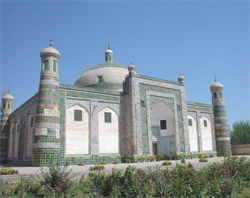| CHINA XINJIANG COMFORT NATURE-TOUR INTERNATIONAL TRAVEL CO.,LTD | |||||
| |
|||||
Abakh Khoja Tomb
The tomb served as the family tomb of Abakh Khoja, the powerful ruler of Kashgar in the 17th century who was revered as a prophet and second only to Mohammed. It was first built in 1640 and contained 72 members belonging 5 generations of the family. Emperor Qianlong’s favored concubine-Xianggei(fragrant Concubine) was also said to be buried here. The tomb is otherwise called Xiangfei Tomb. Entering the main gate, visitors will see a big rectangle-shaped courtyard, which contains a gate tower, higher and lower worship walls, Doctrine-Teaching Hall, an orchard and the main tomb chamber. The gate tower is small while very brilliant. Close to the gate tower is a small mosque, which is used as a daily service hall for the local muslins. A larger church in the west part of the cemetery is where many important religious activities take place. Muslims from South Xinjiang Province will come here to do massive liturgy before they go to worship the Abakh Khoja Tomb each Friday or on important religious festivals. In the north part there is a doctrine-Teaching Hall toped with a green dome. The building complex is majestic and mosque-like with dome-toped buildings, minarets and wooden fences integrated harmoniously. The tomb chamber in the east of the cemetery is the main building in the complex. It is the largest dome-style architecture found in Xinjiang. The tomb chamber is 35 meters wide, 20 meters high. The wall circled the chamber is over 10 meters high. The dome of the main tomb chamber has a diameter of 17 meters. The top of the dome is covered with bright glazed titles. At each corner of the tomb base erects a huge column with a diameter of 3.5 meters. At each column’s top, there is a small minaret with a crescent symbol. The ceiling of the chamber is decorated with delicate colored patterns and Arab words. Inside the chamber there is a staircase leading to the top. Of the 72 royals in the tomb, the most famous resident, however, is a Uygur concubine (Xiangfei) of Qin’s emperor Qianlong. After her death, the hear-broken emperor had Xiangfei carried by royal caravan all the way back to her hometown. The site is thus well known among Chinese as Xiangfei Tomb. |
|||||
 Abakh Khoia Tomb is at the northeast suburbs of Kashgar at Hanhao Villages, around 5 kilometers away form the city. The environment in that area is tranquil and beautiful with lush green vegetation, dense forest. The grand tomb is heavily sheltered by the ancient poplar trees which grow around the mausoleum.
Abakh Khoia Tomb is at the northeast suburbs of Kashgar at Hanhao Villages, around 5 kilometers away form the city. The environment in that area is tranquil and beautiful with lush green vegetation, dense forest. The grand tomb is heavily sheltered by the ancient poplar trees which grow around the mausoleum.